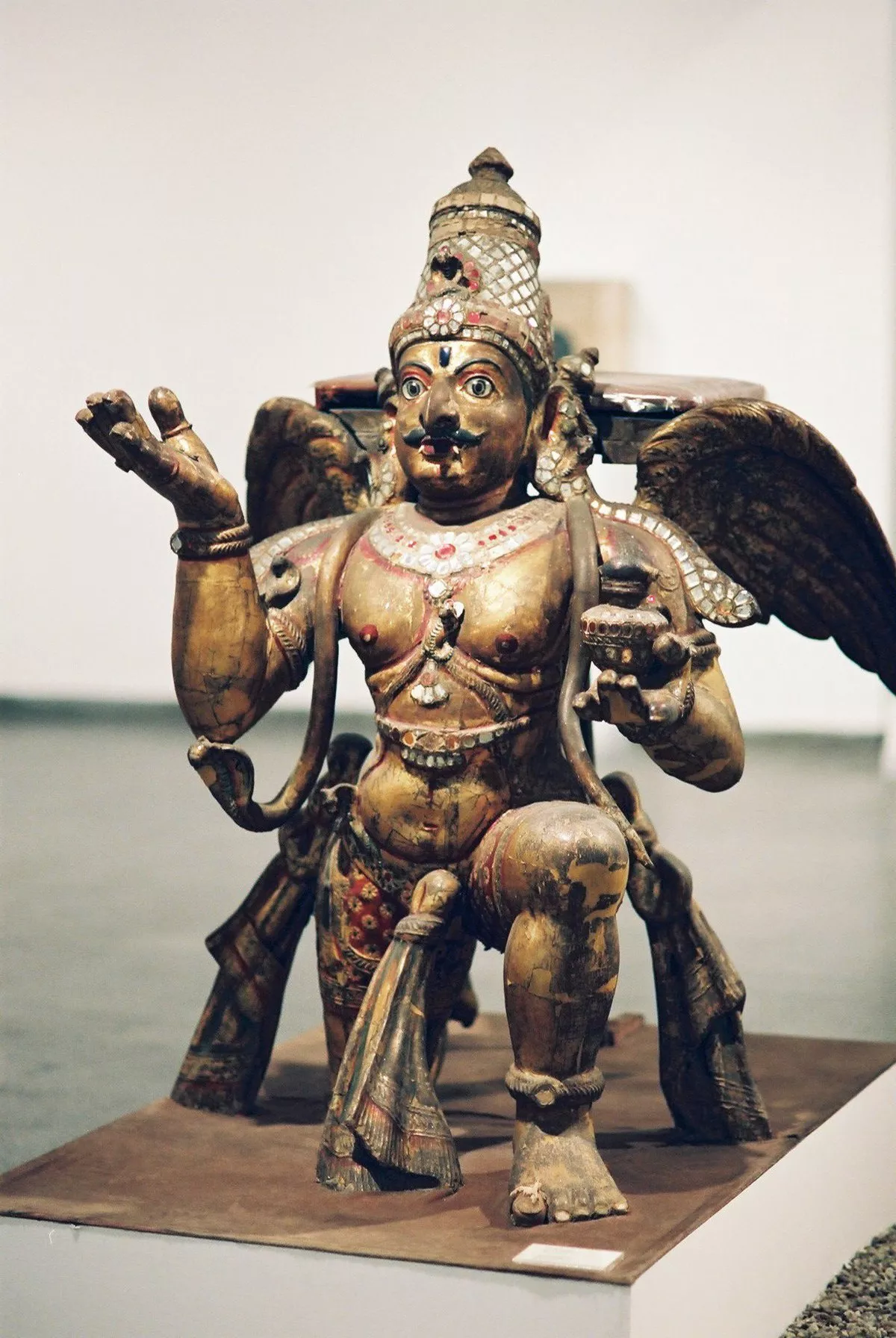 1.
1. Garuda is a Hindu deity who is primarily depicted as the mount of the Hindu god Vishnu.

 1.
1. Garuda is a Hindu deity who is primarily depicted as the mount of the Hindu god Vishnu.
Garuda is the half-brother of the Devas, Gandharvas, Daityas, Danavas, Nagas, Vanara and Yakshas.
Garuda is the younger brother of Aruna, the charioteer of the Sun.
Garuda is mentioned in several other texts such as the Puranas and the Vedas.
Garuda is described as the king of the birds and a kite-like figure.
Garuda is shown either in a zoomorphic form or an anthropomorphic form.
Garuda is generally portrayed as a protector with the power to swiftly travel anywhere, ever vigilant and an enemy of every serpent.
Garuda is a part of state insignia of India, Indonesia and Thailand.
Garuda is a powerful creature in the epics, whose wing flapping can stop the spinning of heaven, earth and hell.
Garuda is described to be the vehicle mount of the Hindu god Vishnu, and typically they are shown together.
Garuda is the younger brother of Aruna, who is a charioteer of the sun god, Surya.
Garuda is a metaphor in the Vedic literature for Rik, Saman, Yajna, and the atman.
The Hindu texts on Garuda iconography vary in their details.
Garuda's hands, recommends the text, should be in abhaya posture.
In Sritatvanidhi text, the recommended iconography for Garuda is a kneeling figure, who wears one or more serpents, pointed bird-beak like nose, his two hands in namaste posture.
In some iconography, Garuda carries Vishnu and his two consorts by his side: Sridevi and Bhudevi.
Garuda iconography is found in early temples of India, such as on the underside of the eave at Cave 3 entrance of the Badami cave temples.
Garuda's mythology is linked to that of Aruna, the charioteer of the Hindu sun god Surya.
Garuda later asked his brothers to free his mother from her slavery, to which they demanded Amrita from heaven.
Garuda waged a war against gods with his extraordinary might and abilities, and defeated all of them, including Indra.
Garuda then took Indra's nectar vessel and flew back to earth.
Vishnu then came to Garuda, and asked him to be his ride, to which he agreed.
Indra requested that Garuda not give the Amrita to the Nagas though, as it would bring great trouble later, so they forged a plan.
Garuda is presented in the Mahabharata as one who eats snake meat, such as the story about him planning to kill and eat Sumukha snake, where Indra intervenes.
Vishnu teaches a lesson to Garuda and cured his pride on might.
The Suparnakhyana, a late Vedic period poem considered to be among the "earliest traces of epic poetry in India," relates the legend of Garuda, and provides the basis for a later, expanded version which appears within the Mahabharata.
Garuda is found on the faces of many early Hindu kingdom coins with this symbolism, either as a single-headed bird or a three-headed bird that watches all sides.
Powerful warriors advancing rapidly on doomed foes are likened to Garuda swooping down on a serpent.
Garuda, referred to as Garula, are golden-winged birds in Buddhist texts.
In Buddhism, the Garuda are enormous predatory birds with a wingspan of 330 yojanas.
On some occasions Garuda kings have had romances with human women in this form.
The Garuda are enemies to the naga, a race of intelligent serpent- or dragon-like beings, whom they hunt.
Garuda is later reborn as Song dynasty General Yue Fei.
The Story of Yue Fei plays on the legendary animosity between Garuda and the Nagas when the celestial bird-born Yue Fei defeats a magic serpent who transforms into the unearthly spear he uses throughout his military career.
Hsia explains the reason why Qian Cai, the book's author, linked Yue with Garuda is because of the homology in their Chinese names.
The Garuda is a yaksha or guardian for Shantinatha in Jain iconography and mythology.
Garuda became the national emblem of Thailand and Indonesia; Thailand's Garuda is rendered in a more traditional anthropomorphic style, while that of Indonesia is rendered in heraldic style with traits similar to the real Javan hawk-eagle.
The word Garuda is literally derived from Sanskrit.
The Garuda Pancasila is coloured black or gilded, symbolising both the greatness of the nation and the elang Jawa.